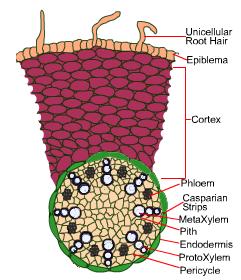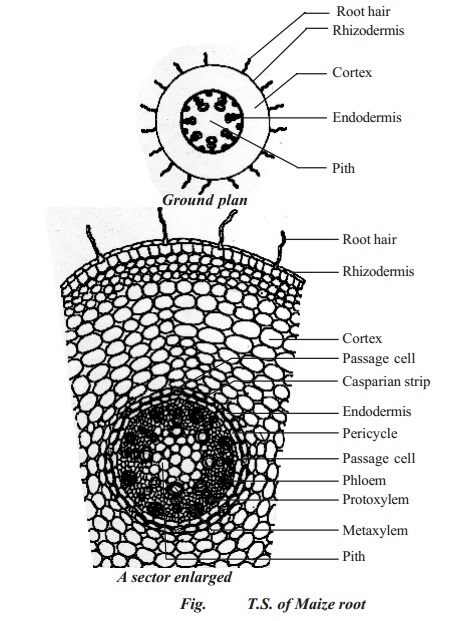Epidermis
- It is the outermost layer composed of a single layer of cells.
- Unicellular hairs are present.
- Cuticle and stomata are absent.
Cortex: It is similar to dicot root, and is composed of parenchyma cells.
Endodermis
- It is composed of compactly arranged barrel-shaped cells.
- The lateral walls of the cells have casparian thickenings.
- In some cases, thin walled cells are found near to the protoxylem cells. These cells are called passage cells. Transport of water and food from stele to cortex occurs through these cells.

Stele
- The pericycle is single layered, made of thin walled parenchyma cells.
- Pith is large and well developed. It forms the central part of the stele.
- It is made of thin walled parenchyma cells which later becomes thickened or lignified.
- Vascular bundles are arranged radially.
- The xylem is in exarch condition.
- The number of xylem (varies from 12 – 20) is greater than that of dicot roots. Hence, it is called polyarch.
- The phloem is composed of sieve tubes and companion cells.
- The conjunctive tissue is made of parenchyma cells.

| Dicot Root | Monocot Root |
| Cortex – large | Cortex – small |
| Cortical parenchyma – Irregularly arranged | Cortical parenchyma – Uniformly arranged |
| Stele – small | Stele – large |
| Casparian strips – Present on the radial walls of endodermis | Casparian strips – Present on the radial and inner tangential walls of endodermis |
| Pith – Usually absent, and very small if present | Pith – large |
| Xylem & Phloem – Few in number | Xylem & Phloem – Numerous |
| Xylem vessel outline – Polygonal | Xylem vessel outline – Oval |